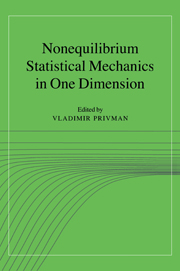Book contents
- Frontmatter
- Contents
- Contributors
- Preface
- Part I Reaction-Diffusion Systems and Models of Catalysis
- Part II Kinetic Ising Models
- Part III Ordering, Coagulation, Phase Separation
- Part IV Random Adsorption and Relaxation Processes
- Part V Fluctuations in Particle and Surface Systems
- Part VI Diffusion and Transport in One Dimension
- 17 Some recent exact solutions of the Fokker-Planck equation
- 18 Random walks, resonance, and ratchets
- 19 One-dimensional interacting random walks in a random environment
- Part VII Experimental Results
- Index
- Abbreviations
18 - Random walks, resonance, and ratchets
Published online by Cambridge University Press: 18 December 2009
- Frontmatter
- Contents
- Contributors
- Preface
- Part I Reaction-Diffusion Systems and Models of Catalysis
- Part II Kinetic Ising Models
- Part III Ordering, Coagulation, Phase Separation
- Part IV Random Adsorption and Relaxation Processes
- Part V Fluctuations in Particle and Surface Systems
- Part VI Diffusion and Transport in One Dimension
- 17 Some recent exact solutions of the Fokker-Planck equation
- 18 Random walks, resonance, and ratchets
- 19 One-dimensional interacting random walks in a random environment
- Part VII Experimental Results
- Index
- Abbreviations
Summary
Two recent developments involving activation and transport processes in simple stochastic nonlinear systems are reviewed in this chapter. The first is the idea of ‘resonant activation’ in which the mean first-passage time for escape over a fluctuating barrier passes through a minimum as the characteristic time scale of the fluctuating barrier is varied. The other is the notion of active transport in a fluctuating environment by so-called ‘ratchet’ mechanisms. Here, nonequilibrium fluctuations combined with spatial anisotropy conspire to generate systematic motion. The fundamental principles of these phenomena are covered, and some motivations for their study are described.
Introduction
The study of the interplay of noise and nonlinear dynamics presents many challenges, and interesting phenomena and insights appear even in onedimensional (1D) systems. Examples include Kramers’ fundamental theory of the Arrhenius temperature dependence of activated rate processes, Landauer's further insights into the role of multiplicative noise, and the theory of noise-induced transitions. This chapter reviews more recent developments which go beyond those studies in that the characteristic time scale of the fluctuations plays a major role in the dynamics of the system, whereas the phenomena in are fundamentally white-noise effects. Specifically, the two effects to be described in this chapter are the phenomena of ‘resonant activation’ and transport in ‘stochastic ratchets’.
Resonant activation is a generalization of Kramers’ model of activation over a potential barrier to the situation where the barrier itself is fluctuating randomly.
- Type
- Chapter
- Information
- Nonequilibrium Statistical Mechanics in One Dimension , pp. 359 - 370Publisher: Cambridge University PressPrint publication year: 1997



